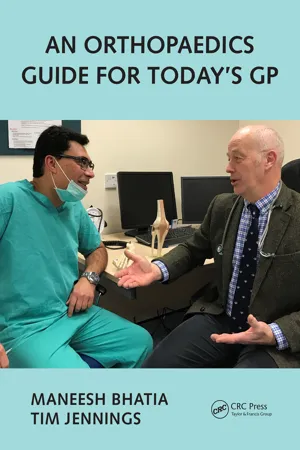
- 187 pages
- English
- ePUB (mobile friendly)
- Available on iOS & Android
An Orthopaedics Guide for Today's GP
About this book
This practical handbook is an essential reference for GPs when dealing with musculoskeletal disorders, as well as a useful exam prep aid for the common MSK cases that occur in the CSA. Responding to increasing pressures on GPs to reduce the number of referrals and treat more patients in the community, the book covers a breadth of orthopaedic disorders, with clear colour photographs and diagrams to demonstrate techniques in practice.
Chapters are authored by experts in each disorder with GP input, putting a strong focus on diagnosis and easy-to-follow processes for deciding courses of action and investigation. Each section explores the range of treatment options for that topic, including step-by-step injection techniqueswhere relevant, and signposts need-to-know areas with 'red flags'.
This is an important reach-for guide to assist GPs with easy diagnosis and to provide clear direction on next recommended steps.It will also be useful for medical students takingorthopaedicsmodules.
Frequently asked questions
- Essential is ideal for learners and professionals who enjoy exploring a wide range of subjects. Access the Essential Library with 800,000+ trusted titles and best-sellers across business, personal growth, and the humanities. Includes unlimited reading time and Standard Read Aloud voice.
- Complete: Perfect for advanced learners and researchers needing full, unrestricted access. Unlock 1.4M+ books across hundreds of subjects, including academic and specialized titles. The Complete Plan also includes advanced features like Premium Read Aloud and Research Assistant.
Please note we cannot support devices running on iOS 13 and Android 7 or earlier. Learn more about using the app.
Information
1
Paediatric orthopaedic disorders
Introduction
| Physiological Conditions | Pathological Conditions |
| Usually symmetrical | Rarely symmetrical |
| Flexible deformity – correctable | Rigid deformity |
| Familial (family history positive) | Family history positive or negative |
| Improves with time | Usually worsens with time |
| No active treatment generally necessary | Intervention is almost always needed |
What ages do the different normal variants present?
- Packaging deformities
- Physiological flat foot (pes planus)
- Physiological bow legs (genu varum)
- Knock knees (genu valgum)
- In-toeing
- Out-toeing
What are packaging defects?
- Hyper-extension of the knee
- Postural talipes/calcaneovalgus foot
- Out-toeing of infants as a result of external rotator contracture
- Metatarsus adductus
In-toeing and out-toeing
Table of contents
- Cover
- Half Title
- Title Page
- Copyright Page
- Dedication
- Table of Contents
- Foreword
- Preface: Maneesh Bhatia
- Preface: Tim Jennings
- Editors
- Contributors
- 1 Paediatric orthopaedic disorders
- 2 Spine disorders
- 3 Shoulder disorders
- 4 Elbow disorders
- 5 Hand and wrist disorders
- 6 Hip disorders
- 7 Knee disorders
- 8 Foot and ankle disorders
- 9 Bone and soft tissue tumours/lumps and bumps
- 10 Preoperative fitness and perioperative issues in MSK patients
- 11 Rheumatology for general practitioners
- 12 The role of physiotherapy for musculoskeletal disorders in primary care
- 13 Musculoskeletal disorders – the GP perspective
- Index